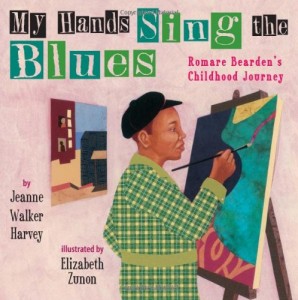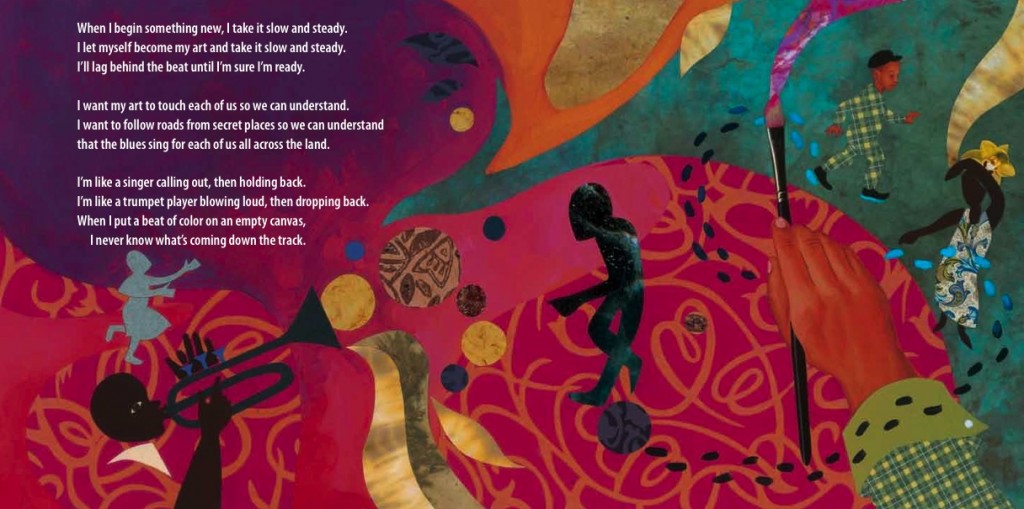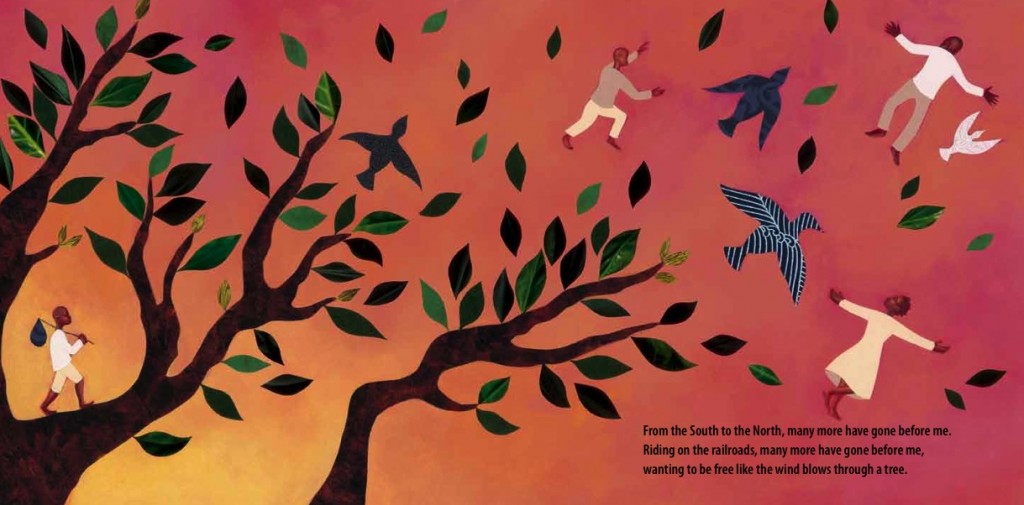By Nicki Richesin, The Children’s Book Review
Published: October 24, 2011

Jeanne Walker Harvey is the author of a fascinating new children’s book My Hands Sing the Blues which traces the childhood migration of young Romare Bearden as he leaves his grandparents in Charlotte, North Carolina and then moves to New York City to eventually become a great painter during the Harlem Renaissance. Her remarkable book is filled with striking collages and poetic, jazz-inspired lines that mimic perhaps what influenced Bearden most as an artist: his childhood home and music. Harvey is also the author of Astro the Steller Sea Lion and she blogs about children’s narrative nonfiction books at True Tales & A Cherry on Top. She lives in Marin County, California with her husband and an adorable black Lab who sleeps at her feet while she writes.
Nicki Richesin: Congratulations on your exquisite children’s book My Hands Sing the Blues. I fell in love with the dreamy artwork and your rhythmic poetic telling of Romare Bearden’s childhood story. I read that you were first inspired by Bearden’s paintings while working as a docent at the San Francisco Museum of Art. What about his artwork captivated you and moved you to create your book?
Jeanne Walker Havery: Thank you so much, Nicki, for your kind words. It’s truly been an amazing experience to be part of this creative journey. And I really appreciate the opportunity to be interviewed by you as I think The Children’s Book Review is a terrific site and resource for families, teachers, librarians AND writers!
 Yes, my docenting work at SFMOMA is exactly what inspired me to write this book. I was giving tours to school groups of the comprehensive Romare Bearden’s exhibit organized by The National Gallery when I fell in love with his art. As a teller of stories, I loved that his paintings told stories, especially the stories of his childhood in Charlotte, North Carolina. I found that I could hardly get the students to move on to the next painting in my tour because they were so engaged and drawn to his art, especially the huge vibrant collages. That’s when I decided that I would love to write a picture book about Bearden and the “people and the places” of his Charlotte childhood which he said was such an inspiration for his art.
Yes, my docenting work at SFMOMA is exactly what inspired me to write this book. I was giving tours to school groups of the comprehensive Romare Bearden’s exhibit organized by The National Gallery when I fell in love with his art. As a teller of stories, I loved that his paintings told stories, especially the stories of his childhood in Charlotte, North Carolina. I found that I could hardly get the students to move on to the next painting in my tour because they were so engaged and drawn to his art, especially the huge vibrant collages. That’s when I decided that I would love to write a picture book about Bearden and the “people and the places” of his Charlotte childhood which he said was such an inspiration for his art.
Although Romare Bearden worked in different media, how important was it to you that the illustrator Elizabeth Zunon’s collages reflect his artwork? Some of the illustrations, where she inserted lilies and daisies growing from “roots sunk deep in my childhood long past,” reminded me of his painting “Madeline Jones Wonderful Garden.”
I can’t tell you how thrilling it was to open the envelope from the publisher with the proofs and see Elizabeth Zunon’s illustrations. I feel they are truly stunning! I think Liz not only paid homage to Romare Bearden’s art and style, but also brought her own incredible talent and creativity in the interpretation of the text. For example, on the last spread of the book, I was moved by the way she drew Romare walking along leaving behind his footprints or his “track” which reflects (in a way I hadn’t thought about) the words, “When I put a beat of color on an empty canvas, I never know what’s coming down a track.”

And yes! I hadn’t thought of the comparison before, but you’re absolutely right. Liz’s vivid collage flowers of varying sizes and intensity do echo “Madeline Jones Wonderful Garden” in her unique style.
In your author’s note, you write that Bearden was heavily influenced by jazz during the Harlem Renaissance. On the dedication page, you include a quote from Bearden, “You put down one color, and it calls for an answer. You have to look at it like a melody.” Did this line inspire you to employ repetition in your verse within the book?
Yes. That line and several other quotes by Romare Bearden discussing the importance of jazz and blues music as inspirations for his art. Jazz and blues music were not only important to him because of the content, the social and historical significance, but also the method of creating the jazz music, the improvisational aspect. I read that he was good friends with the modern artist, Stuart Davis who was also a jazz fanatic, and together they would visit NYC jazz clubs and talk about art. Or they would go to baseball games together and talk about the connection of jazz and art. And I loved learning that at one point Bearden painted in a space right above the Apollo Theater in Harlem and could hear live jazz from his window.
How much research did you do on Bearden’s life as you were working on the book? Did anything surprise you about his past?
I tried to read everything I could find about Bearden’s life, and in particular the books by Ruth Fine (curator of modern art at The National Gallery), Myron Schwartzman and Kevin Brown were invaluable. I also attended lectures by the staff of SFMOMA when the Bearden exhibit was exhibited. And luckily, Bearden participated in many interviews and wrote articles so I was able to read his comments first hand which is always the best research, I think.
Lots of things surprised me about him. For one thing, he worked full-time as a social worker in New York for a good portion of his adult life while he painted in the evenings. Also, he didn’t have a degree in art. He graduated from NYU with a degree in education, and had previously studied mathematics. But he was always attending art classes, in college and places such as the Art Students League in NYC. He also studied extensively on his own, not only world art, but music, history and literature, the influence of all of which can be seen in his paintings. My favorite Bearden photo is the one of him smiling and standing in front of shelves and shelves of books with his big cat perched on a ladder.
Also, for several years, Bearden wrote song lyrics, but his friends guided him back to painting. And he was also a great athlete. He played baseball in college and pitched for a semipro team in the summers. But professional baseball at the time was still segregated. He was offered a major league contract if he was willing to pass as white, but Bearden refused. He was truly a man of many talents, but I’m glad he focused on his art.
You were recently a featured speaker at the Family Fun Day at the Mint Museum in Charlotte, North Carolina (Bearden’s hometown and the setting for your book). What were your impressions of the exhibit and the community of Charlotte? Did you feel as if you were channeling Bearden’s spirit by being there?
I’m so glad you asked me about my visit because I want to sing the praises of the stunning new Uptown Mint Museum and Charlotte. Everyone I met was so welcoming and interested in the book. The museum staff made me feel like royalty (or a rock star, as my son said) for the day, and the audience was very engaged and enthusiastic. It truly was a thrill to be in Charlotte, Romare Bearden’s birthplace and the setting of my book, and to meet people who lived there. During my reading, I was very excited to say the words “Today my memory whirls back to my North Carolina past,” and I couldn’t resist asking the Charlotte audience to join in the refrain. I also had a chance to visit the incredible exhibit of Bearden works on paper at The Harvey B. Gantt Center for African-American Arts + Culture across the street from The Mint Museum.
Before my talk, I spent a few hours soaking up the Mint Museum’s amazing “Romare Bearden: Southern Recollections” exhibit that includes about 100 collages, paintings and watercolors, including the painting that I saw at SFMOMA which inspired me to write this book, “Watching the Good Trains Go By.” Truly wonderful! I’m so in awe of Romare Bearden that I wish I could say I was able to channel his creative spirit there, but I certainly thought about him constantly.

What projects are in the works for you now?
I’m working on several different picture book projects, all narrative nonfiction and focusing on creative people. The books are in varying phases, and pretty much put on hold right now as I savor promoting and sharing My Hands Sing the Blues.
It’s truly a dream come true for me to have this book published that not only focuses on this amazing artist and his creative process, but also the importance of the connections we all have to the people and places in our lives.
Thanks very much for interviewing me, Nicki. And good luck with your books!
For more information, visit: https://www.jeanneharvey.com/
Add this book to your collection: My Hands Sing the Blues: Romare Bearden’s Childhood Journey
Nicki Richesin is the editor of four anthologies,What I Would Tell Her: 28 Devoted Dads on Bringing Up, Holding On To, and Letting Go of Their Daughters; Because I Love Her: 34 Women Writers Reflect on the Mother-Daughter Bond; Crush: 26 Real-Life Tales of First Love; and The May Queen: Women on Life, Work, and Pulling it all Together in your Thirties. Her anthologies have been excerpted and praised in The New York Times, the San Francisco Chronicle, The Boston Globe, Redbook, Parenting, Cosmopolitan, Bust, Daily Candy, and Babble.

1 Comment
Pingback: Romare Bearden « Artmanews!